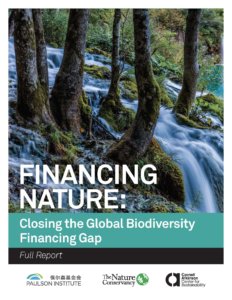
The Asian Infrastructure Investment Bank’s (AIIB) annual meeting brings together the Bank’s senior leadership with shareholders (country governments) and other stakeholders (business, NGOs, etc.). This year’s meeting marked the first time AIIB included a dedicated session on biodiversity. PI’s Vice Chairman and Executive Director Deborah Lehr was invited to speak on a panel with Professor Sir Partha Dasgupta, University of Cambridge; Aban Marker Kabraji, Former Regional Director of the Asia Regional Office, International Union for Conservation of Nature; Prof. Kongjian Yu, Professor, Peking University, which was moderated by Sir Danny Alexander, Vice President for Strategy and Operations, AIIB.
Below are Lehr’s prepared remarks for the October 28 session.
Many thanks to the AIIB for highlighting one of the serious crises that the world is facing today—the loss of biodiversity in the world. I am honored to be joining such a prestigious group. The Paulson Institute is pleased to be part of this initiative.
Risks of biodiversity loss, although not as well-understood as those of climate change, are likely to be of a similar scale, potentially even greater.
There are two main types of risk:
Economic risks
There is currently no calculation of the benefits—or more important—the losses stemming from natural assets, often considered free goods. We know it is not easy to put a price on the services that nature provides, but it is essential that we try.
Risks of biodiversity loss, although not as well-understood as those of climate change, are likely to be of a similar scale, potentially even greater.
 In a report jointly published by the Paulson Institute and the Nature Conservancy, Financing Nature, we estimate that the loss of pollinators alone could lead to a drop in annual agricultural output of more than $200 billion.
In a report jointly published by the Paulson Institute and the Nature Conservancy, Financing Nature, we estimate that the loss of pollinators alone could lead to a drop in annual agricultural output of more than $200 billion.
- Add the secondary service of pollinating non-food crops such as alfalfa, the main feed for cattle, and the impact rises to more than $500 billion a year.
Pollination is just one of the benefits of biodiversity that we can measure—and for every benefit that we can measure, there are many more that we cannot.
- In financial terms, birds, bees, and trees are valuable assets.
Public health risks
Evidence suggests that as we destroy and degrade nature, people come into contact with stressed ecosystems in a way that increases the risk of transmission of zoonotic diseases. This leads to an ongoing concern of pandemics such as the like we have seen. There is a direct link between biodiversity, pandemics, and economic growth. The good news is that policymakers have started to recognize the importance of protecting nature-based assets.
While international attention and the UN process for biodiversity loss are a long way behind climate change, there are some signs that they are catching up. As an important start, we are seeing a growing groundswell of political will—critically important for creating the right policies and legislation if we are to see progress. For the first time, the G7—under the UK leadership—made some meaningful commitments on the importance of biodiversity.
There is a direct link between biodiversity, pandemics, and economic growth. The good news is that policymakers have started to recognize the importance of protecting nature-based assets.
This was followed by China’s hosting of the CBD COP 15, which in addition to important commitments by countries and the issuance of the Kunming Declaration, President Xi announced the Kunming Biodiversity Fund. China committed $230 million to support biodiversity protection in developing countries, which are often the most vulnerable to biodiversity loss.
We are also encouraged that the G-20 and obviously COP 26 will have biodiversity on the agenda. Now clearly the primary focus of the COP 26 will be climate change. Some people say “let’s deal with climate change first, then tackle biodiversity loss.” This would be a mistake. It is vital that we deal with both crises together in an integrated way. There are real risks of making well-intentioned progress on climate change yet exacerbating biodiversity loss. Think of the footprint of a wind or solar farm, if not placed appropriately.
Biodiversity Financing
PI’s Financing Nature report showed that the gap between what the world spends on biodiversity conservation today versus what is needed over the next ten years is around $700 billion per year
The report also showed that we can significantly reduce the size of the gap by addressing two major issues—including in low-cost ways:
- first, by removing or redirecting subsidies harmful to nature, for example in agriculture, forestry, and fisheries;
- second, by integrating biodiversity risk management into financial decision-making.
We know that government funds, especially in the current context of the pandemic recovery, will be nowhere near enough to protect our most important biodiversity. So it is essential that we steer the trillions of public and private sector investment away from projects that do harm to nature towards projects that protect and restore nature. And although the potential of the private sector investment is enormous, to be clear, this investment won’t happen unless governments put in place the right incentives and regulatory frameworks to make it happen.
Role of Financial Institutions
The role of international financial institutions is vital; for example, the eight largest multilateral development banks (MDBs) manage a total of $1.83 trillion of assets. According to a recent report from Finance4Biodiversity, 40% of development bank portfolios are invested in countries and sectors which are highly dependent on nature, for example through land and water use. So given the vulnerabilities, MDBs should ensure that their investment portfolios take account of the dependency risk and do not increase biodiversity loss. They should be aware of the risk in their portfolios.
Just as multilateral development banks are committing to ensuring their investments are consistent with the Paris Agreement on climate change through the “Paris Alignment” process, they must also commit to ensuring their investments are consistent with the Kunming Declaration on biodiversity, adopted at the High-Level Segment of the first part of CBD COP 15 on October 13, 2021 and the forthcoming global biodiversity framework due to be approved at COP 15 part two in the spring 2022.
I applaud AIIB for putting biodiversity onto the agenda of your Annual Meeting and engaging with shareholders and stakeholders about how to integrate biodiversity risk management into AIIB’s strategy and operations. To accelerate this process, I encourage AIIB to build an institutional culture and capacity to manage biodiversity risks effectively. Specific and concrete actions AIIB can take includes:
- Commit, at CEO and Board levels, to meaningful targets, actions, and changes in practices,
- Establish and enforce lending and investment practices that reduce harm to biodiversity,
- Establish and enforce lending and investment practices that promote nature protection, and
- Create and support internal culture, systems, frameworks, metrics, and tools to assure success.
Thank you. And Paulson Institute is committed to supporting the Bank in every way we can to help develop an effective response to this most important and urgent of challenges.



